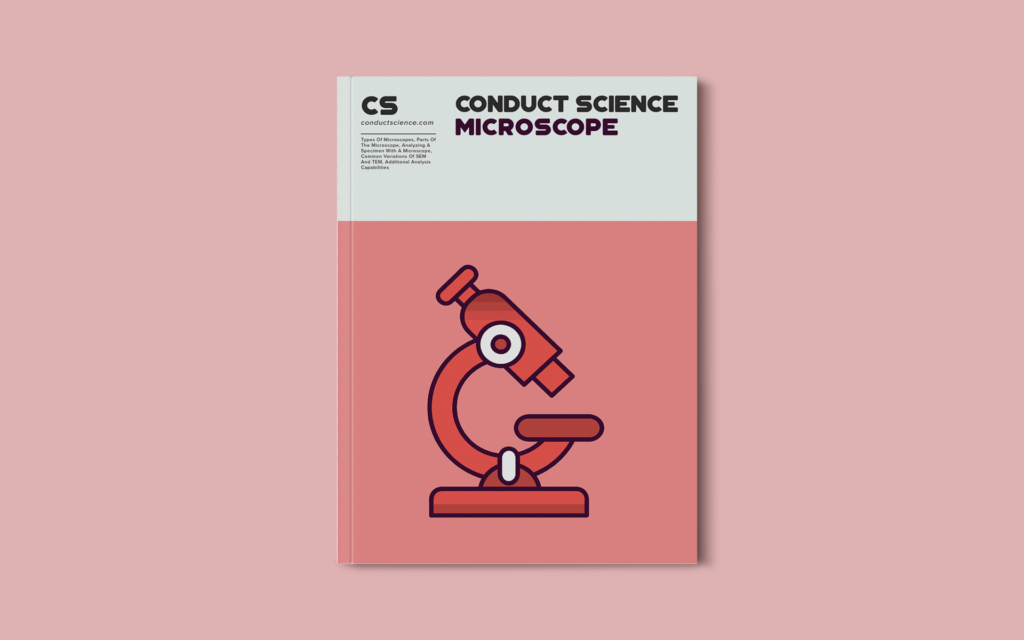

As an Amazon Associate Conductscience Inc earns revenue from qualifying purchases
An electron microscope is an imaging instrument that uses a beam of energetic electrons to observe objects on a very fine scale. Electron Microscopes were developed to overcome the limitations of light microscopes which can only visualize the specimens with 500x or 1000x magnification and 0.2 micrometers resolution. In the early 1930’s the scientific desire to visualize the fine details of the intracellular components and organelles rose. This required 10,000x plus magnification which led to the development of the electron microscope. Max Knoll and Ernst Ruska developed it in Germany in 1931. In the electron microscope, a focused beam of electrons is used to “see-through” the specimen. This examination can yield information about the surface features of an object, morphology, composition and crystallography.
The basic steps of the electron microscopy involve; the electron gun generates a stream of highly energized electrons. This stream is bombarded onto the specimen (with a positive electrical potential) while is limited and focused with the help of metal apertures and magnetic lenses into a thin, focused, monochromatic beam. This beam irradiates the sample and interactions inside the irradiated sample occur, affecting the electron beam. These interactions and effects are captured and transformed into an image.
In an electron microscope, an ‘electron beam’ is used to produce the image and the ‘electromagnetic field’ is used for the magnification. Electrons are subatomic particles orbiting around the nucleus. Electrons fly off form the atom after the metal is excited by heat. In the electron microscope, tungsten is heated by a high voltage current to form a continuous electron stream. Magnetic coils are used in the electron microscope to focus the beam on the specimen and illuminate it.
The wavelength of light is inversely proportional to the resolving power. The wavelength of green light is 1,10,000 times greater than that of an electron beam; therefore; despite its smaller numerical aperture the electron microscope can resolve objects as small as 0.001µ. This makes the resolving power of the electron microscope 200 times greater than that of the light microscope.
The electron microscope consists of an electron gun, electromagnetic lenses, and an image viewing and recording system. The electron gun is a heated tungsten filament which generates an electron beam. The condenser lens focuses this beam on the sample. A second condenser lens is used to form a thin tight electron beam. An accelerating voltage is applied to move electrons down the column. The highly energized electrons pass into the condenser lenses, which then focus them on the specimen. The electrons pass through the specimen and are scattered depending upon the thickness of the different regions of the specimen. The scattered electrons come out of the specimen and pass down to the magnetic coils called the objective lens, which forms the intermediate magnified image. Finally, the other set of magnetic lenses called projector or ocular lenses produce the final magnified image.
Note: Perform all the steps on a desk covered with a strip of Parafilm.
The electron microscopy is a powerful imaging tool to delineate the cellular events involved in autophagy. The cells were prepared for electron microscopy and embedded with resins. Under the electron microscope, autophagic compartments are observed as membrane-bound vesicles loaded with cytoplasmic material or organelles. Ribosomes were frequently seen in the autophagic vesicles. High stain retaining in the limiting membrane suggested that the membrane has a high content of unsaturated lipids. The study validated the value of electron microscopy in studying the cellular events for biomedical research.
The electron microscopy has been used in various fields as a diagnostic tool in vitro, which provides efficient resolution for better interpretation and imaging. A number of studies have been done employing the electron microscopy to visualize the fine cellular and subcellular structure such as photoreceptors (rod and cone cells), retinal pigment epithelium (RPE), outer plexiform layer, inner plexiform layer, bipolar cells, ganglion cells, and nerve fiber layers. Furthermore, the electron microscopy has successfully been used to reveal the pathological conditions such as light-induced photoreceptor degeneration, age-related muscular degeneration, synaptic plasticity, and other retinal pathologies. The electron microscopy is a very promising technique to decipher the molecular mechanism of the pathological state, the conformational changes of the proteins, and the visualization of the cellular ultrastructure.
The electron microscopy combined with the light microscopy has wide applications in visualizing and characterizing the morphological and conformational alterations of the viral replication cycle. The cells were prepared and infected with the viruses. The electron microscopy revealed the remodeling of the viral core and the rearrangement of the surface glycoproteins of the virus to shape the entry claw upon host receptor binding. The assembly, maturation, and the release processes complete the viral replication cycle. It was found that the assembly of non-enveloped viruses occurs in the cytoplasm or the nucleus of the cell and they lyse the cell for release. In contrast, the enveloped viruses attain a lipid bilayer that is derived from cellular membranes. The electron microscopy provides detailed mechanistic insights into the processes of viral replication cycle that will play an important role in providing spatiotemporal parameters of biological processes and help to unveil the molecular composition of involved molecular complexes.
The electron microscopy is a useful imaging tool for the diagnosis of neuromuscular conditions. The electron microscopy provides with a specific diagnosis by unveiling the ultrastructural features such as inclusions within muscle fibers, cylindrical spirals, and reducing bodies of the neuromuscular pathological states. The technique could also aid in the diagnosis of muscular dystrophies, neurogenic atrophy, myotonic diseases, and congenital, metabolic, and inflammatory myopathies.
